Abstract
The fragmentary statue of the famous general Neshor called Psamtek-Menekhib, hailing from the city of Mendes, has been an object of interest for a generation of Egyptologists, in particular for its hieroglyphic text. Published and cited many times since its discovery, the statue was first identified in Cairo in 1947. After a long journey through some European private collections and auctions, it was acquired by the Museo Egizio in Turin in 2002. Its condition changed significantly between 1947 and 2002: the lower part of the original back-pillar disappeared and a modern face was added. This article traces Neshor’s long journey from Cairo to Turin, shedding light on the practices of the Egyptian antiquities market in Egypt and abroad during the 20th century, and on the role played in it by Egyptologists such as those who documented the statue.
Introduction
The fragmentary statue Suppl. 19482 of the famous Neshor called Psamtek-Menekhib from Mendes (a well-known Saite official of the 26th Dynasty), currently housed in the Museo Egizio in Turin, has been recognized by specialists and philologists since the beginning of the 20th century as a remarkable example of the period. The main role of Neshor was to supervise, and ensure security at, the Egyptian borders. In addition to his honorific titles and epithets, his many administrative offices show that he played a leading role in the Egyptian army, and represents a good example of the military face of the Egyptian administration in the late Saite Period.
While this statue has been previously published,1 its modern history still needs to be clarified. After 1947, when it was identified for the first time in an antiquities shop in Cairo, the statue suddenly disappeared from the antiquities market to resurface only in 2002, when the Museo Egizio acquired it at Venetian border customs. It was then kept for some years in the storerooms of the Museo Egizio, before again attracting the attention of Egyptologists in 2010. An important monument for the late 26th Dynasty, the statue is now fragmentary, missing its lower part and back pillar. The presence of a modern face representing a pharaoh reveals the impact of modern history on the appearance of such objects.
This article aims to present the artistic features of this statue, which is a good example of a Late Period private monument, as well as to present a series of archival photos together with new facsimiles and translations of its autobiographical texts. Finally, we will trace the journey of the statue through the Egyptian-antiquities market for over fifty years, bringing new contributions to the understanding of the networks, attitudes, and approaches of the actors in this market, which deeply impacted the formation of the great museum collections of Egyptian art.
1. A fragmentary bust of an official in the 26th Dynasty
Among the artworks today displayed in the Museo Egizio in Turin is a fragmentary statue (Suppl. 19482) of a famous official, Neshor named Psamtek-Menekhib (Fig. 1), dating from the 26th Dynasty. In its extant character, as well as in its details, the statue is a fitting example of the artistic trends of the period. Originally thought to be carved in basalt, a favorite Late Period material for sculpture, a closer inspection reveals that it is of granodiorite.2 With a polished surface typical of Late Period sculptures, the bust is modeled with great attention to certain details of anatomy.
Statue Turin S. 19482 in its present state. Photo: Museo Egizio, Turin.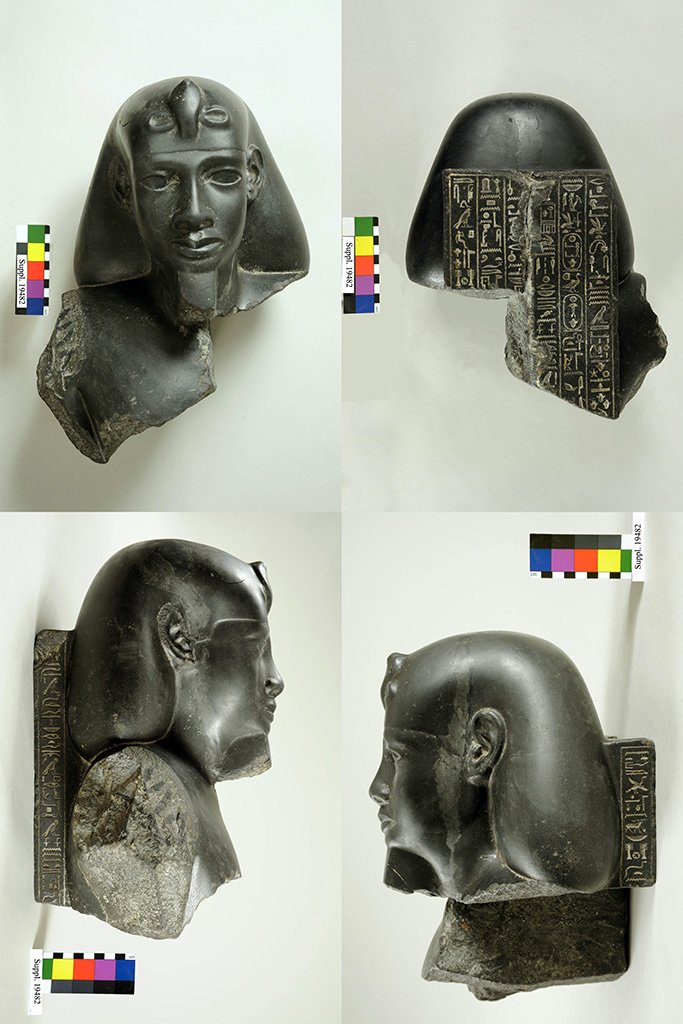
Its dimensions, in its current state, are:
- Whole statue: h 42 cm; w 32 cm; d 20.5 cm (26 cm including the modern face);
- Left fragment: h 42 cm; w 19 cm; d 20.5 cm;
- Right fragment: h 23.5 cm; w 13 cm; d 17 cm;
- Back pillar, right half: h 26.5 cm; w 10 cm; d 3 cm
- Back pillar, left half: h 13 cm; w 9 cm; d 3 cm;
- Width of hieroglyphic columns: 3 cm;
- Face: h 25.5 cm; w 15 cm; d (at the nose) 5.5 cm;
- Ears: h 6.5 cm; w 4 cm.
Statue Turin S. 19482 after Rosenbaum removed its modern face (see below, section 3.4). Photo: Michel Valloggia.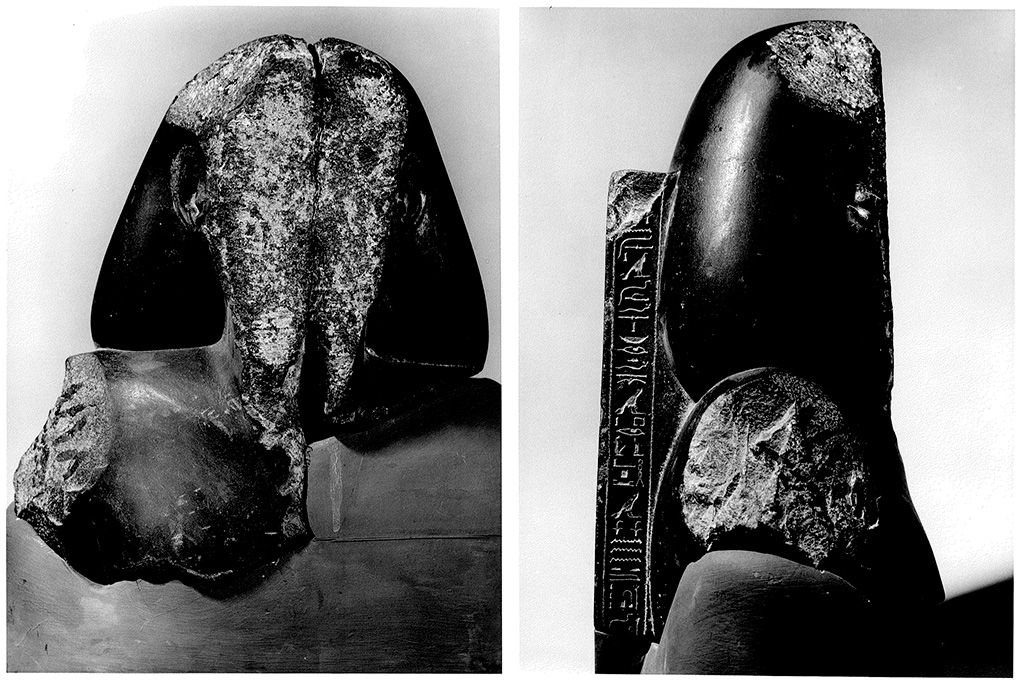
The first characteristic of this figure that catches our attention is the modern face that has been added where the original was missing (Fig. 2). The restored part of the face can easily be distinguished, even though it seems to have been carved in the same material as the ancient fragments (Fig. 3).3 The modern fragment has been joined with the two ancient ones using a resin that was painted on its surface in a dark
Statue Turin S. 19482 with its modern face. Photo: Vincent Pelisson/Maxence Garde.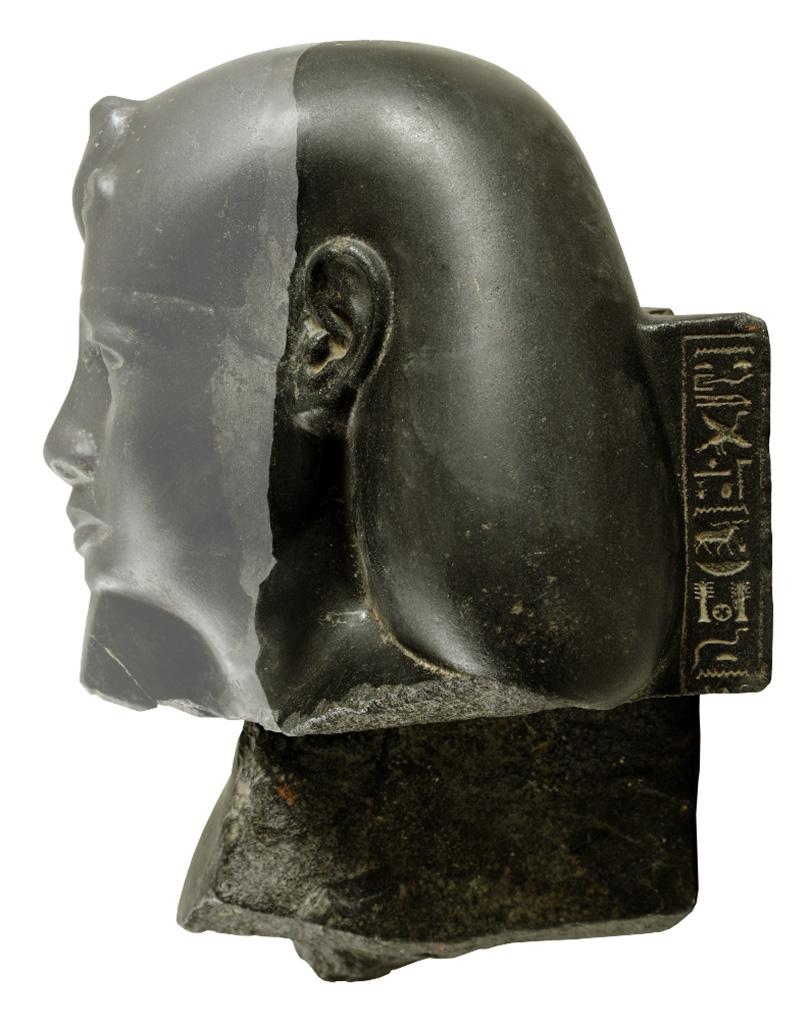
Of the original part of the head and torso, apart from the noticeable ears and round wig, not many features have survived. Set well under the neck, we can see the right collarbone, carved as an obliquely curving ridge, although slightly more discreet than other examples from this period.4 This particular feature has been widely discussed as an element indicating a geographical provenance from Lower Egypt during the Late Period. While most examples from this period from Lower Egypt show slanted collarbones like on our statue,5 they are not present on every sculpture from the Late Period,6 keeping us from definitive conclusions. Under the collarbone, we perceive the upper part of the rounded pectorals, and the side view shows their projection emphasized by the receding line matching the fracture. An inscription written with modern Egyptian numbers can be seen on the broken surface of the right shoulder of the statue. The outlined number is painted in black and reads ٧١٨ (718), while there is a second inscription drawn with white paint and visible on the lower part of the same shoulder, reading 5. We will get back to these two inscriptions later in our article.
The fragmentary condition of the piece keeps us from identifying further characteristics, and also from telling whether the statue was originally standing or kneeling.7 This information would have been interesting as, while Neshor is known through all of five monuments,8 indicating his leading role during the reigns of Psamtik II (595-589 BC) and his son Apries (589-570 BC), of these monuments only two are complete enough to show the attitude in which he was portrayed.9 A high official from the army and part of the royal administration, Neshor was in charge of the customs operating at Egypt’s border. His military role might explain the fact that Neshor dedicated monuments in various locations throughout his whole career.10 The autobiographical inscription on the back pillar of our statue mentions Mendes (modern Tell el-Rub’a), a Delta city that achieved its greatest political prominence during the Late Period.11 During the Twenty-Sixth Dynasty, King Apries built the southern part of the local temple (established in the Eighteenth Dynasty and rebuilt during the Ramesside period), installing four monumental granite naoi placed on limestone bases.12 These naoi were dedicated by Amasis to the gods Shu, Re, Osiris and Geb and demonstrated the importance of the city for the Saite rulers. This justifies Neshor’s choice to dedicate one of his statues to the city and its deities, the ram-god Banebdjedet, the fish-goddess Hatmehit, and their son Harpakhered, as does the fact that Mendes was the most important center of the nome where he was established.
While being a significant example of a private
2. Transliteration and translation of the texts on the back pillar
The hieroglyphic inscription preserved on the back pillar is laid out in six vertical columns on the back and a column on the left and one on the right side. All eight columns are incomplete, and the junction of the third and fourth column of the back pillar has been damaged by the splitting of the statue into two fragments (Fig. 4).
Virtual reconstruction of Turin Suppl. 19482 with the now missing third fragment.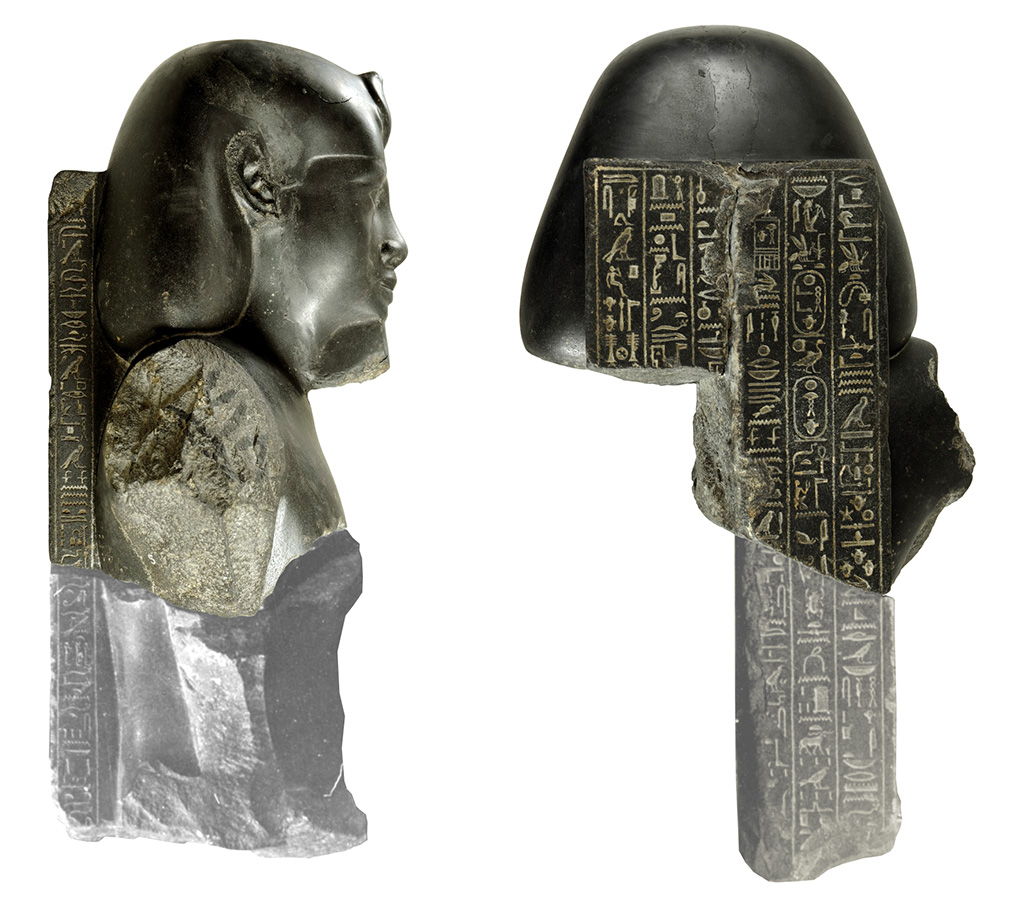
Our transliteration and translation of the texts on the back pillar take into account ancient photos, notes and drawings coming from the archives of B. Bothmer, J.-J. Clère and J. Yoyotte,14 other previous publications – from that of O. Perdu15 to the recent one by H. Bassir16 – as well as our own facsimile of the surviving parts, based on recent photographs and an epigraphic survey in the storerooms of the Museo Egizio in Turin (Fig. 5). The parts of texts on the lower fragment of the left half, today lost, are indicated inside double brackets [[ … ]]. Notes are given for some words and excerpts that still present difficulties in translation or epigraphic issues.
Facsimiles of the inscriptions of the back pillar, by Matteo Lombardi (surviving parts, black) and Jean Yoyotte (missing parts, red). Montage by Matteo Lombardi.
I. Back side, 6 columns, right to left:
(1)
(2)
(3)
(4)
(5)
(6)
(1) The noble and prince, the seal-bearer of the King of Lower Egypt, the sole friend, the wake for the army (A) on the day of fighting, the great of heart on the day of the fray(B), the one who pacifies hearts [[becomes furious, possessor of favors on all accounts, the overseer of the menefit troops(C)[…] ]]
(2) for my Lord, the King of Upper and Lower Egypt, Haaibre, Son-of-Re, Wahibre, living forever. I praised god and listened to him. [[ I completed(D) the chapels of the Great Bas. Never was the
(3) Horus, Wahib. It is before the Lord of the Two Lands that my favors exist, in exchange for this that (I) have done. His Majesty presented gifts [[ which (I) created with (my) own arms [ (?) … oasis (?) … ] ]]
(4) [the very] good (?) (wine?) [of the southern oasis (?), for every (?)(E) […]
(5) on a stela of greywacke stone, which was set up in the temple […]
(6) as a follower of Horus-the-Child, the Great God who resides at Mendes […]
Right side, 1 column, right to left:
(1)
(1) [… the Ki]ng(?) Neshor, he says: As for every man who will cause disorder in the temple of Osiris-Hapy concerning those things which are in the writings, and who will dam[[age his image, and his statues, having given them to somebody else so that he (re)inscribes [them(?) … ] ]]
III. Left side, 1 column, right to left:
(1)
(1) which comes from the divine-offering of Banebdjed and of […]
Notes:
(A) The epithet
(B) As for the group  , the sign of the star has been widely discussed and two values have been proposed, viz.,
, the sign of the star has been widely discussed and two values have been proposed, viz.,
(C) For the military title
(D) For the reading  is to be understood as a graphical variant of the verb
is to be understood as a graphical variant of the verb
(E) Bassir and Heise do not try to give a translation of this very badly preserved excerpt of column 4: see especially Heise, Erinnern und Gedenken, 2007, p. 204 and n. 515. We take into account the hypothetical restoration given in Perdu, BSFE 118 (1990), p. 44 and p. 45, fig. 2(a):  , with a
, with a  , the preserved traces of hieroglyphic signs remain difficult to understand: is
, the preserved traces of hieroglyphic signs remain difficult to understand: is  to be intended as a capacity measure for a wine offering, as Perdu proposed? It is worth remarking that Yoyotte’s transcription gives a
to be intended as a capacity measure for a wine offering, as Perdu proposed? It is worth remarking that Yoyotte’s transcription gives a  basket instead of a
basket instead of a  .
.
3. From Cairo to Turin, the long journey of Neshor
As is well-known, the collecting of ancient Egyptian sculpture began significantly prior to the development of archaeology and philology. Consequently, much material is out of context, even today.17 Furthermore, a great majority of ancient Egyptian figurative art is fragmentary, with the owner’s inscription lost or incomplete. Historians must then depend on the clues offered by iconography and style in order to establish the authenticity of an object and date it.18 When iconography has been unfortunately altered, making an object’s overall appearance oddly distorted, our role is to understand when these changes occurred. A new field of study, called “provenance research”, has recently arisen around this role, which retraces the modern history of artworks and their chain of ownership in order to recover additional information that might have been lost along
This paper traces this sculpture’s provenance history to examine the art market and collecting practices of the early twentieth century, when collectors’ new interest in objects as historical documents made antiquities with a known provenance all the more valuable. Fragments such as this, acquired on the Egyptian antiquities market, are particularly important for what they reveal about market trends and acquisition practices in the Middle East during the second part of the twentieth century, when major changes occurred within the international antiquities market. A proliferation of fakes and copies in the European market during this period undoubtedly led to rising concerns about the authenticity of objects.21 Collectors traveled outside Europe to enlarge their collections by purchasing antiquities in large numbers at low cost from local dealers.22 This statue representing Neshor emerged at a unique moment in the practice of collecting antiquities in Egypt and Europe. From the 1930s, the relationships between Egyptologists and dealers slowly evolved into a role of monitoring, photographing, and taking notes on any object likely to be of interest for their scholarly research or for the collections of the museums they collaborated with. Their visits were mainly directed to Cairo and Luxor, the two main antiquities trade centers in Egypt. Precisely for this reason, our investigation starts in Cairo.
3.1. Maurice Nahman
Maurice Nahman in his gallery in 1945. Source: Maurice Nahman, Antiquaire. Visitor book and miscellaneous papers. 1909-2006. Brooklyn Museum of Art.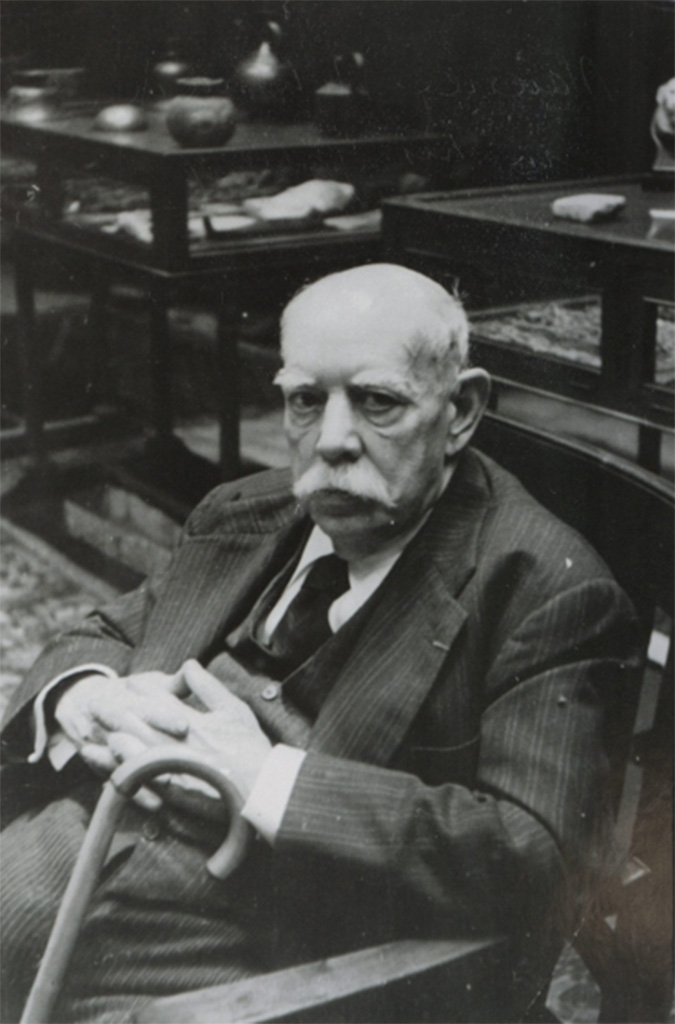
The journey of our statue begins in November 1947, when three fragments of an ancient Egyptian statue of hard black stone were seen in the shop of Maurice Nahman23 (Fig. 6). These were described as “three (joined) fragments of a statue”24 by Jacques-Jean Clère, a French Egyptologist and professor at the École Pratique des Hautes-Études in Paris. This description can be found in his “dealers’ files”,25 his personal records about various antiquities he encountered, sometimes photographed or drawn, while visiting dealers in Egypt and France from 1927 to 1981.26 He most notably recorded inscribed monuments that he sometimes published27 or could show to his students. The two men knew each other for a long time, and Clère visited the Egyptian dealer regularly. Maurice Nahman was a chief-cashier at the Crédit Foncier Égyptien until 1924, when he retired and devoted himself to his antiquities gallery. His gallery was installed in a Cairene palace, 27 Sharia el-Madabegh, later known as “Casa Nahman”28 (Fig. 7).
Interior of Maurice Nahman’s gallery around 1935. Photo: L’Ibis Gallery Ltd.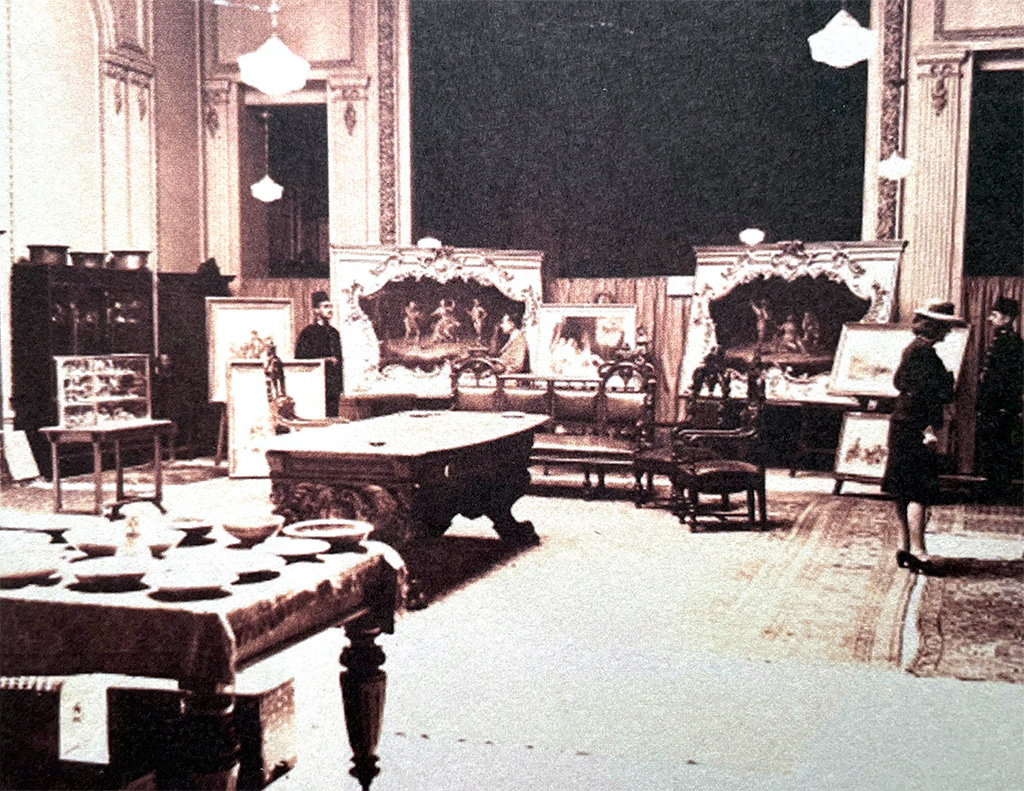
The quality of the stone, its trimness and, most importantly, the partly survived hieroglyphic inscription, attracted the interest of Jacques-Jean Clère. As a philologist, he was particularly interested in inscriptions, and so he quickly understood the importance of the three pieces despite their fragmentary appearance. From the photographs that Clère took in 1947, we can see the original condition of the Neshor statue
Detail of the left side of the statue’s head in Nahman’s gallery showing the two inventory numbers M7509 and N9280. Photo: MSS Clère, The Griffith Institute, The Sackler Library, Oxford.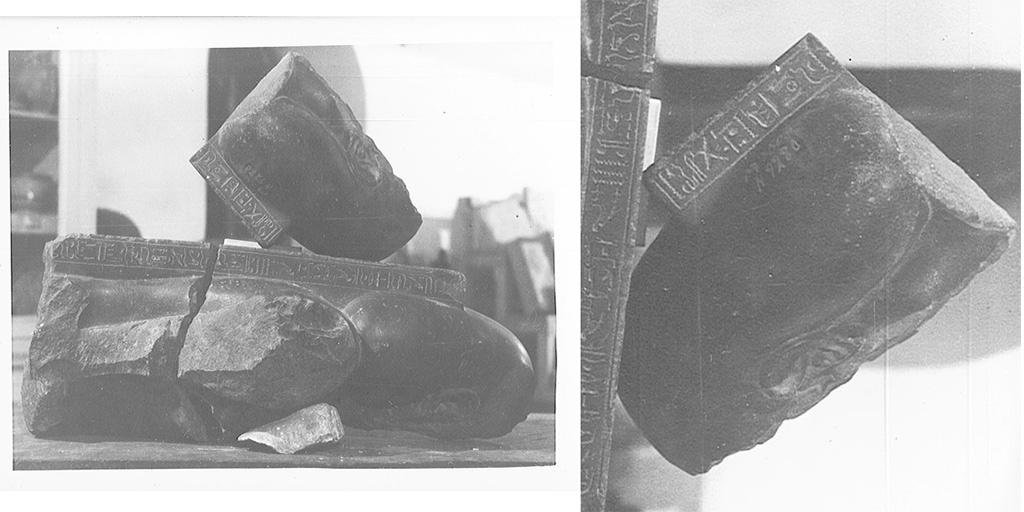
Nahman was certainly the most important antiquities dealer in Cairo at that time. After World War II, the structure of the antiquities trade changed significantly. Since 1912, the dealers had to be officially registered in the Antiquities Service list of authorized shops.30 They were assigned a license number that had to be mentioned on every document issued after a transaction. Invoices and inventory journals had to be kept up-to-date and ready to be presented to the Service if needed. Nahman took advantage of these changes, establishing a new model of selling antiquities. He introduced himself as a purveyor to Egyptian collections, ensuring the overall quality of the pieces he was selling. He even used advertising to promote himself over other Egyptian dealers. Beyond his interesting commercial approaches, Nahman’s success was also due in large part to his understanding of Egyptian art as a scholarly field. That would explain why he was always keen to welcome foreign scholars to his gallery. Since some Egyptologists were proper buyers,31 Nahman figured out that being approachable for the Egyptological community would help him to build a solid reputation and attract new customers. Most Egyptologists were affiliated with institutions or museums and willing to buy antiquities recommended by their colleagues.
When Clère saw the three fragments in Nahman’s gallery, he wrote some notes to record the information he would need to create a “dossier d’antiquaire” for it32 (Fig. 9). Thanks to his thoroughness, we know from his documentation33 that he saw the fragment in November 1947, accompanied by Georges Posener.34 This information about Georges Posener might explain why Clère took pictures of these fragments, although he was not studying inscriptions from the Late Period at that time. In his correspondence,35 Clère mentions that Posener was the one most interested in the statue’s inscriptions, as Posener was a specialist of the 27th Dynasty, also known as the Persian period.36
J.J. Clère’s file ANT-47-D recording the information he had about the three fragments of Neshor’s statue. Photo: MSS Clère, The Griffith Institute, The Sackler Library, Oxford.
In his notes, Clère mentions three joined fragments of a sculpture — the photographs show the two pieces we described earlier, along with a third fragment completing the right side of the statue. This third part displays more of the back pillar inscription, with the three lines of the right side (the breaks damaged the leftmost column, which is now difficult to read). The side of the fragment shows a section from the drop of the pectoral to where the kilt must have been before the statue was broken in pieces. There is no remaining detail of the costume, and the point of view of the photograph does not allow us to see the front part of the fragment. A closer look at the photographs (Figs. 8-9) allows us to observe two numbers painted in white, located on the left fragment, where the round wig meets the pillar. These two numbers read N9280 and M7509 and relate to the inventory policy of Maurice Nahman for his antiquities. Some sold through his gallery still bear an inventory number, such as a fragmentary statuette of a vizier in the Metropolitan Museum of Art.37 These numbers were used by Maurice Nahman in the descriptions given in
Extract from Maurice Nahman’s ledger book for the reference 7509-9280. Photo: Courtesy of Lucien Viola.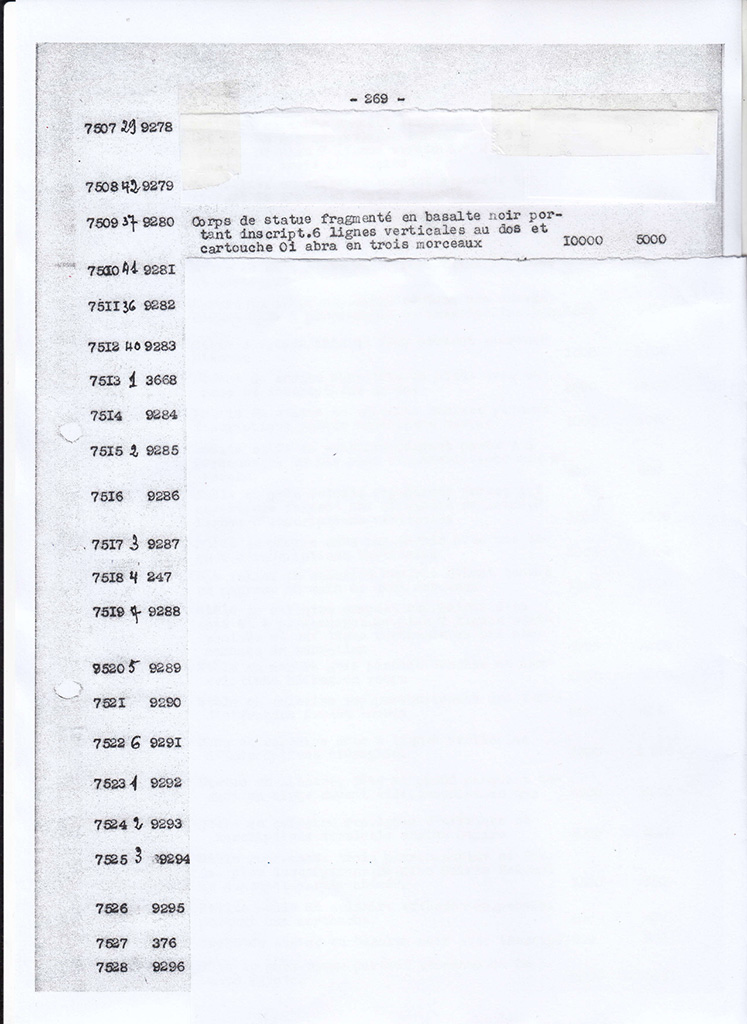
3.2. Robert Viola
Indeed, nine years later, in 1956, the three fragments were still in Cairo, based on the testimony of Jean Yoyotte, who mentions them in one of his dealer’s files from his archives kept at the Centre Wladimir Golenischeff (EPHE, PSL).40 Yoyotte recorded some of the artworks he saw while visiting antiquities dealers in Egypt and France, and collected his notes into nine notebooks. In the first of these, the fragments from the Neshor statue are illustrated with both a drawing and a photograph under the number 38 (Fig. 11). We read the name “Viola” as the reference for the fragments, but with no mention of the year Yoyotte saw them. However, he dated some other objects from the same notebook, so we are dealing with a period between 1952-1956. There is another mention “BVB 361”, referring to a photograph of Bernard Bothmer from the archives of the Corpus of Late Egyptian Sculpture (CLES).41
Extract from Jean Yoyotte’s dealers notebook showing the fragments of the statue of Neshor (lot 38). Photo: Centre Wladimir Golenischeff, EPHE, PSL, Paris.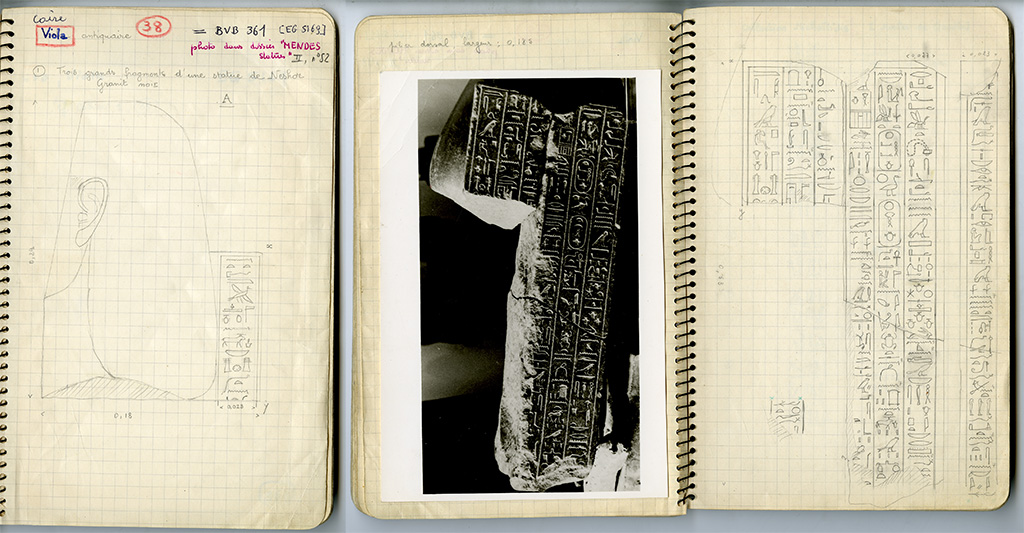
This collection of detailed notes, high quality photographic prints and negatives, mainly of photographs by Bothmer himself, and detailed translations and notes of the inscriptions by Bothmer’s life-long collaborator Herman De Meulenaere, is still housed in the Brooklyn Museum. The corpus specifically documents royal and private stone sculpture from the 25th Dynasty through Roman times.
The mention of the CLES in Yoyotte’s notebook bears witness to the cooperation between Egyptologists who shared information about objects that caught their interest. Clère, Bothmer and Yoyotte had a shared curiosity for the study of Egyptian antiquities on the art market. This specialty helped them to keep track of the same monument over a long period of time. As we can see in the photograph from Yoyotte’s notebook, the three fragments are still together, and there is no modern face added to the statue at that time (as his drawing of the left-side view bears out). Even though this photo does not seem to bring more information than Clère’s pictures, the inventory numbers painted on the left side of the round wig are no longer visible. This detail, along with the different background of the scene, indicates that the statue was no longer identified as belonging to Nahman’s collection at that time.
Robert Viola at age 23, in Cairo. Photo courtesy of Lucien Viola.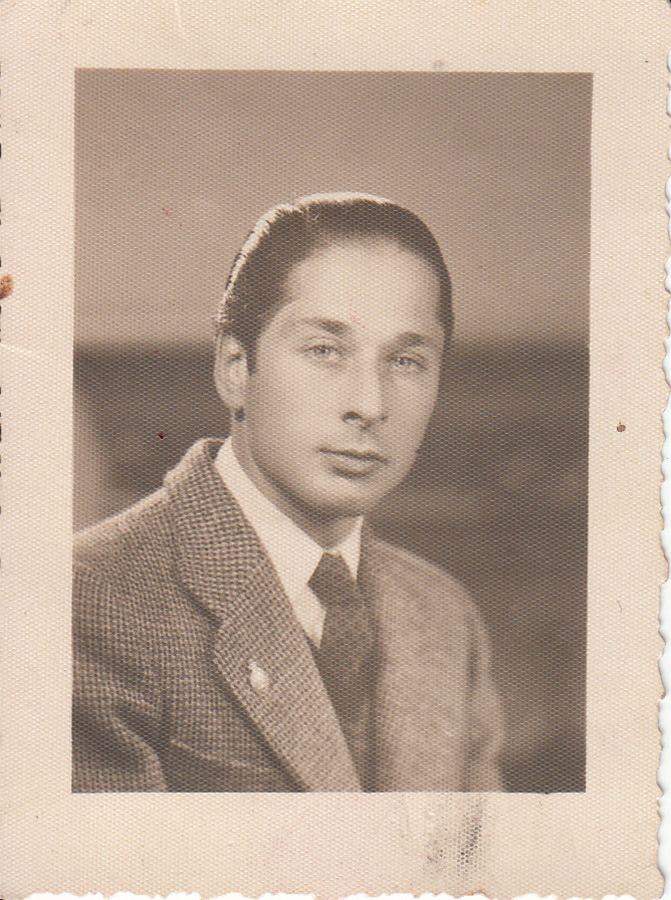
Robert Viola was Maurice Nahman’s second son and assisted his father in the antiquities trade, with his step-brother Robert Nahman (Fig. 12).42 He then became the general manager of the gallery owned by the late Albert Eid43 (1886-1950) located in Khan el-Khalili (Fig. 13), with Simone Eid, Albert’s widow. Robert Viola pursued the clearance of the gallery’s reserve after the nationalization of the shop in 1956. Viola left Egypt in 1963 for New York, where his son Lucien Viola opened a new gallery, L’Ibis Gallery Ltd, in 1971.
The storefront of the Albert Eid & Co gallery in Khan el-Khalili, Cairo. Photo: Claremont Colleges Digital Libraries.
In a summary of his research for the CLES, Bernard Bothmer refers to other photos of the fragments
Scan of Serge Sauneron’s photograph of Neshor’s statue. Source: The Corpus for Late Egyptian Sculpture, Egyptian, Classical Ancient Near Eastern Art Department, Brooklyn Museum of Art.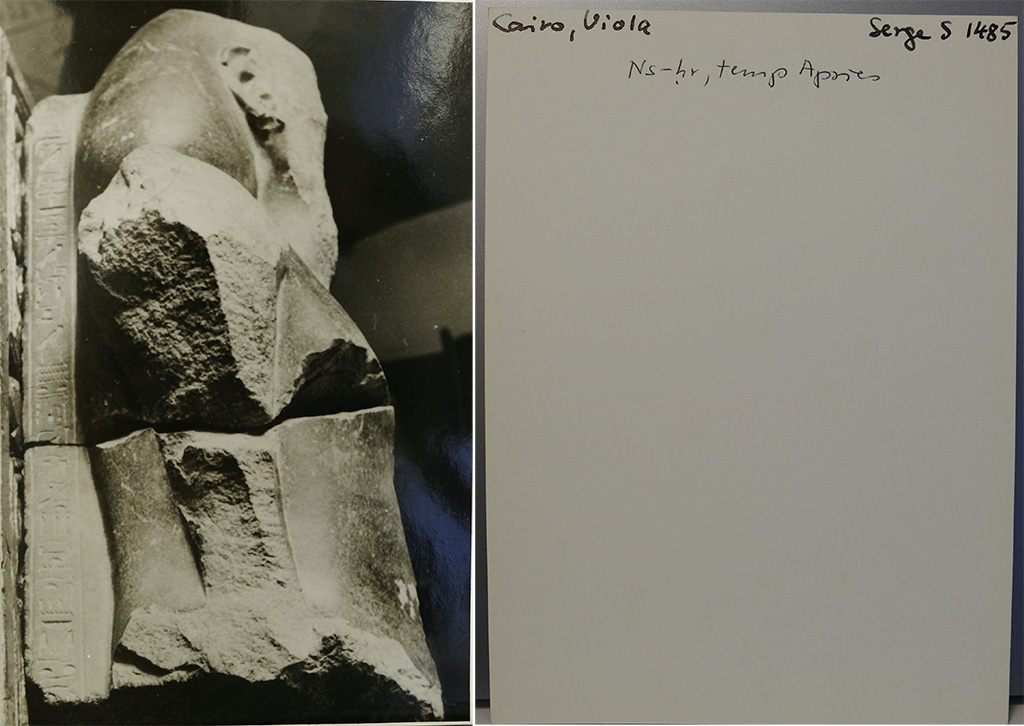
Even if we are able to keep track of the fragments through these archival photographs or notes, some documents are difficult to date. With no mention of the place they were taken, or the name of a dealer or a collector, it is sometimes very difficult to garner information from a picture. This is the case with this shot,45 which shows the statue lying on a cloth with a flower pattern, protecting a wooden floor (Fig. 15). The three fragments can be seen both from the back and from the sides. We can clearly see that the inventory numbers are no longer present, which indicates that the picture was taken after November 1947, when Clère saw the statue. We can only date this photograph from 1947 to 1971, when the statue reappeared in Cairo.
Scan of an untitled and undated photograph of the fragments of Neshor’s statue. Courtesy of Olivier Perdu.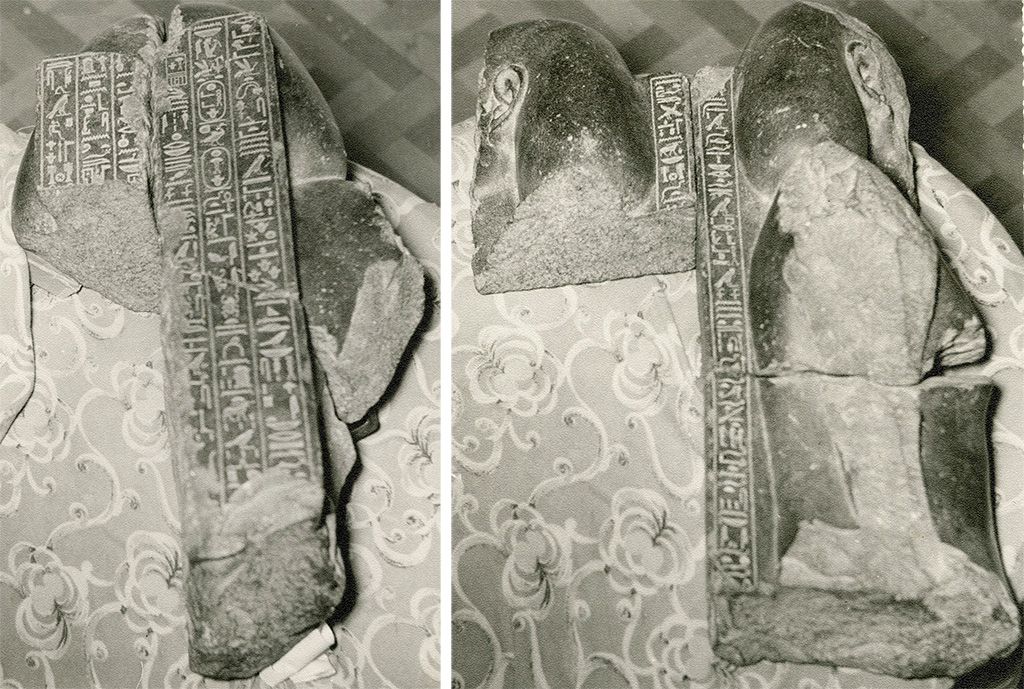
3.3. Sons of Farag el Chaer
The landscape of the Egyptian antiquities trade shifted during the late 1960s and early 1970s. The increasing legislation around antiquities established by the government limited the population of dealers. Many shops were closed and their remaining merchandise was nationalized.46
The long-established clientele of these shops were not buying as many antiquities as before, so dealers had to sell their goods elsewhere. At that time, Egypt became an attractive destination for tourists, and the museum professionals or private collectors looking for rare objects were replaced by wealthy tourists interested in buying a “souvenir” to remember their stay in the land of the Pharaohs. As the customers changed, so did the dealers’ attitudes towards objects. The rediscovery of the statue of Neshor is a good illustration of this new mindset.
Scan of letter headings of “Sons of Farag el Chaer” in Cairo. Courtesy of Alain Zivie.
In March 1971, while he was a young fellow of the Institut Français d’Archéologie Orientale, Alain Zivie accompanied two colleagues visiting some antiquities dealers’ shops in Cairo. While they were in Gamhouria Street, they entered the shop with the sign “Sons of Farag El Chaer, Antiquity Dealer”, registered under the license number 116 (Fig. 16).47 Among the many objects stored there, Alain Zivie spotted a fragmentary statue in black stone. While copying the inscription on the back of it, he realized that it was a monument of Neshor, probably coming from the Delta. Interested in recording the object for a future publication, he then asked for photos of the statue to keep (Fig. 17).48
Photo of Neshor’s statue when it was with “Sons of Farag el Chaer”, Cairo 1971. Courtesy of Alain Zivie.
Based on this photograph, we can see that by 1971 the statue of Neshor already had its modern face and was separated from its third fragment. These modifications happened while the Egyptian antiquities trade was trying to find new potential buyers among a less knowledgeable public. Dealers sometimes decided to restore damaged statues in order to make them more attractive for a new kind of shopper, less interested in the archaeological importance of an object than by its aesthetic appeal.49 With the major part of Egyptian antiquities being sold in Europe or the United States of America, Egyptian dealers found new customers, less concerned about the authenticity of the object they bought than about the authenticity of their buying experience.
We have not been able to identify when the statue arrived in the shop of the “Sons of Farag el Chaer”. Since we know that Robert Viola left Egypt for the United States of America in 1963, he probably would have sold his remaining large antiquities to fellow Egyptian dealers. That might be when the statue was sold to the “Sons of Farag el Chaer”. Although we cannot be absolutely certain, the other inventory number added to the fragments in Arabic script looks like those used by the shop owners on other pieces. The restoration of the Neshor statue could have been arranged by the “Sons of Farag el Chaer” as they were aware of the importance of the statue, based on its geographical origin.50 They may have taken advantage of the exceptional quality of the upper fragments to add a modern face imitating a royal portrait, and to sell it for a better price. Selling the third fragment was a better option, making the new statue easier to transport and thus more attractive for potential foreign buyers.51
In 1973, the owners of “Sons of Farag el Chaer” were arrested, like many other dealers,52 when Presidential Decree 114 was issued. Although most were released shortly after their arrest, the Egyptian antiquities trade definitively moved from Egypt to Europe, together with the statue of Neshor.
3.4. Wladimir Rosenbaum
Clère, Bothmer and Yoyotte were also exchanging photographs with other scholars who might help them to keep track of these objects in private hands. As all were teachers,53 they frequently shared pictures of the monuments they saw on the art market with their students. Through their lessons, many young Egyptologists became acquainted with such monuments. On January 20th 1972, one of Clère’s students at the EPHE, Michel Valloggia, showed him pictures of a bust he had seen in Ascona, Switzerland.
Casa Serodine in Ascona, Switzerland. Photo: Pymouss/CC BY-SA.
Valloggia sent a group of pictures he had received himself from Wladimir Rosenbaum,54 the owner of the Galleria Casa Serodine in Ascona (Fig. 18). The gallery was known for selling Egyptian artefacts among other classical Mediterranean antiquities.55 Wladimir Rosenbaum (1894-1984) was a Swiss lawyer, antiquarian and art dealer of Russian-Jewish descent (Fig. 19). In 1937 he and his wife, Aline Valangin, moved to Ascona, where he lived until 1984 as
Wladimir Rosenbaum (1894-1984). Photo courtesy of Schweizerisches Sozialarchiv
From March 25 to April 25, 1972, Rosenbaum organized, with the Galleria Arte Primitiva56 owned by Paolo Morigi, an exhibition of Egyptian art. The brochure he published for advertisement presented on the cover a photograph of the back of our statue of Neshor (Fig. 20). But only the two upper fragments can be seen in the document. This copy of the brochure is now kept within the CLES in Brooklyn, and was attached to Bothmer’s notes on the statue. In fact, he received an invitation to the show from Rosenbaum, as there would be Late Period sculptures included.57
Brochure for the Egyptian Art exhibition at the Galleria Casa Serodine, March-April 1972. Photo: The Corpus for Late Egyptian Sculpture, Egyptian, Classical Ancient Near Eastern Art Department, Brooklyn Museum of Art.
As Clère and Bothmer both knew through different sources that the Neshor statue was now in Ascona, they updated their files and recorded new information. Unfortunately, their records have come to us incomplete or scattered. In the CLES, the mention of the fragment being with Rosenbaum in Ascona in 1972 is in Bothmer’s summary of the history of the piece, but no document or photograph is directly attached to those from 1956 in Cairo. They are kept in a different file, mentioning a royal statue from the 26th Dynasty.
Although these two different locations for the same object are most likely due to the massive number of documents and references recorded in the CLES, there might be an additional reason for it. The brochure from the 1972 exhibition seems to show that only two fragments were in Ascona; it does not, in fact, show the front of the statue. This may have led to the impression that the photos showed different objects and consequently to the duplication in the archives.
Scans of the photographs of the torso in 1971, while it was with W. Rosenbaum in Ascona, and of the verso with the FERE reference. Source: The Corpus for Late Egyptian Sculpture, Egyptian, Classical Ancient Near Eastern Art Department, Brooklyn Museum of Art.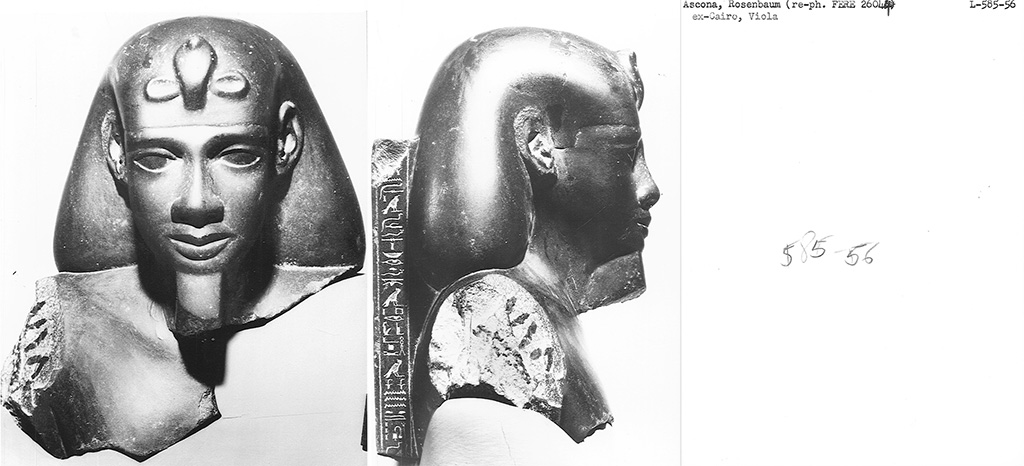
Two more photographs, both kept in the CLES under the FERE reference system,58 help to assess the modifications that occurred on the statue (Fig. 21). These photographs allow us to see the inscriptions drawn on the broken surface of the right arm, as
3.5. Galleria Geri & Casa d’aste Pandolfini
Label of the Galleria Geri in Milan. Source: Di Mano in Mano.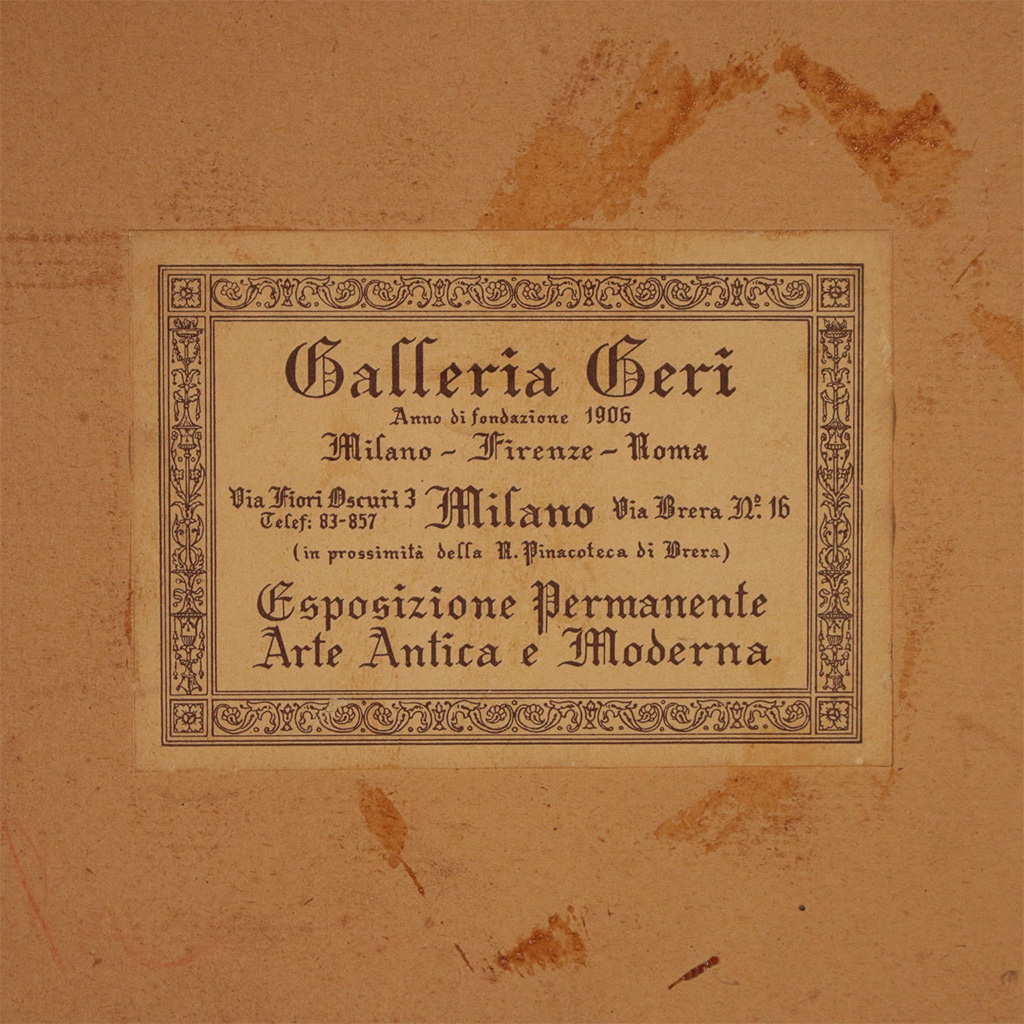
If we look further back through the files of the Museo Egizio for information on how the statue entered the collection, the previous owner mentioned having bought the sculpture in Milan. It seems that at that time the statue was the property of Gallerie Geri,60 founded by Aldo Geri, brother of the famous dealer Alfredo Geri61 from Florence (Fig. 22). Our statue of Neshor seems to have been acquired by the owner in 1977, before being sold to a private collector from Treviso during the 1980s. This means that the restoration of the fragments into a single block with a modern face took place between 1972 and 1977, when it arrived in Milan. The private collector from Treviso was a woman62 who then decided to sell the piece on the Italian art market. The sculpture appeared in the catalogue for an antiquities sale on the 18th of December 1998,
Notice for lot 25 of December 18, 1998 antiquities sale by Pandolfini – Casa d’aste in Florence. Photo courtesy of Pandolfini.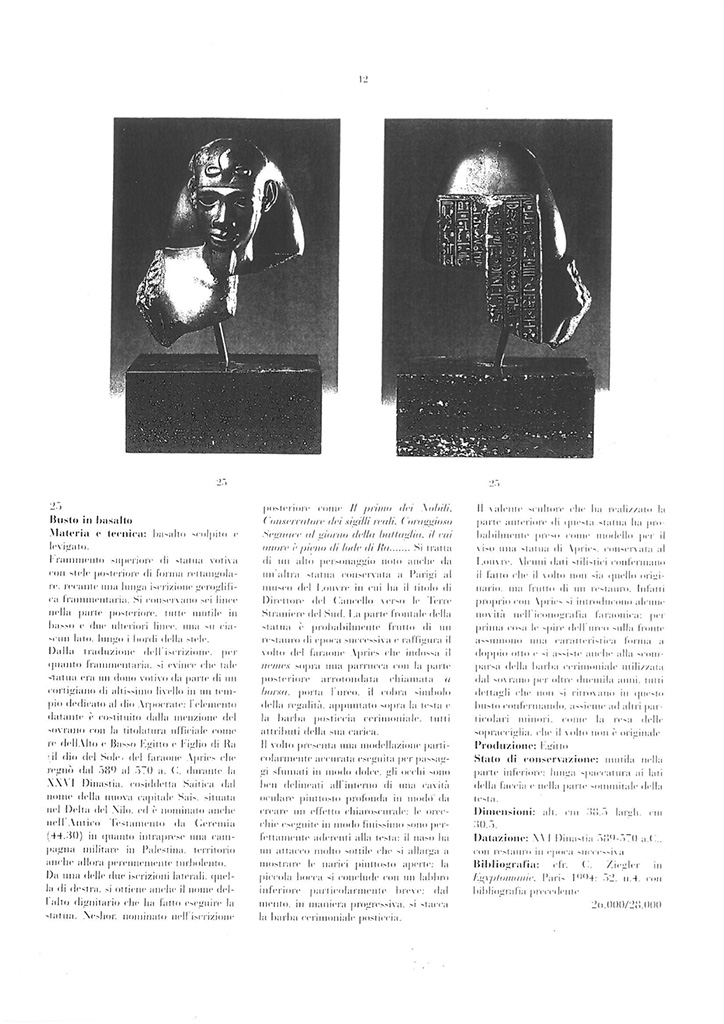
The notice of the auction catalogue mentions the modern parts of the sculpture, and the photograph shows a new pedestal that would explain the presence of a mounting hole in the base of the bust that can still be seen today. The records of the sale show that this lot was not sold and was returned to the owner.63 As the auction result did not meet her expectations, the owner then tried to sell it outside of Italy four years later, in 2002.
3.6. Italian customs and arrival in Turin
The decision to present the sculpture to the border authority was made to legitimate its exportation and ties in with the provenance information given by its notice in the exhibition catalogue Anche le statue muoiono – Conflitto e Patrimonio tra antico e contemporaneo64 from 2018. When the owner brought the statue to the Italian customs office for cultural heritage, the statue was identified as a significant antiquity that might need to be examined by a trained Egyptologist. As the Venetian customs offices did not have an Egyptian antiquities specialist among their staff, they contacted Anna Maria Roveri Donadoni, the Museo Egizio’s director at the time, asking for her expertise. She is the one who first recognized the importance of the sculpture and decided to buy it for the museum, taking advantage of the prerogative of acquisition allocated by the Italian government to public institutions. She charged Elisa Fiore Marochetti65 with the retrieval of the Neshor statue from the Venetian customs offices. That is how the bust entered the Museo Egizio collection. However, the piece was not displayed in the galleries, but left in the museum’s storage. It was only rediscovered, in a sealed wooden crate, by Matteo Lombardi in 2010, during an inventory session. As the crate it was kept in did not have any reference written on it, the sculpture was then recorded and assigned an inventory number, S. 19482.
In 2011, all the data available for the sculpture was recorded by Elisa Fiore Marochetti66 in a three-page document that explores how the piece came into the museum and gives some general information, such as its geographical provenance, a short description, its dating, as well as the condition of the piece. In this section, a specific note is made: “Two longitudinal fragments joined by modern grouting. The face may have been sculpted by reusing the now missing part of the bust, which was originally composed of three fragments.”67
No geological examination of this information has been carried out by the Museo Egizio so far to verify this hypothesis. Even if the dimensions of the third fragment, now missing, had been sufficient to carve the modern face in it, this theory would still remain questionable. The restoration would have been recognizable as such even by non-specialists. The addition of the new face would hardly have made up for the loss of the the third fragment bearing a part of the hieroglyphic inscription.
Conclusion
Our investigation of the “long voyage” of Neshor’s statue through 20th century Egypt and Europe, from the Nile Delta to Turin, has given us the opportunity to rediscover a significant page of the Egyptian
It has also raised the question of restoration of antiquities for aesthetic reasons, even to the cost of diminishing the scientific value of an object. If our conclusion is correct that the restoration happened while the sculpture was with the owners of the shop “Sons of Farag el Chaer” in Cairo, these modifications reflect the shifting attitudes of antiquities dealers towards objects during the 1970s. The relationship between dealers and objects was decisively transformed when potential clients were no longer prestigious private collectors or institutions bent on collecting genuine and meaningful antiquities, but modern buyers brought by the recent development of tourism.
Finally, this study compels us to reaffirm the importance of developing research on museum collections in storerooms, where lots of antiquities are still waiting to be rediscovered. Some objects may not be selected to be displayed because they feature modern additions; on the contrary, they should be, because their modified appearance tells us an interesting story about their “modern history”. Bernard Bothmer pointed out that “[…] over the years too many controversial pieces have come to the attention of experts, curators, scholars, and having been spurned have forever disappeared from sight, often without even having been properly recorded with notes and photographs.”68 Neshor’s statue has avoided this fate, thanks to the connected work and research of this generation of scholars.
Acknowledgements
We are grateful to Federico Poole for his invitation to publish this statue and his continuous support, as well as for the valuable input of the two anonymous reviewers.
Maxence Garde: I would like to thank Diana Craig Patch and Marsha Hill who welcomed me at the Department of Egyptian Art of the Metropolitan Museum of Art. I was fortunate to start my research on the statue during my fellowship there and I would like to thank them for their support throughout that year. This article is part of my Ph.D. research under the direction of Laurent Coulon and Vincent Lefèvre. I would like to thank them for their support and advice. I wish to express my gratitude to Alain Zivie, who kindly contributed his knowledge to this research.
Finally, I wish to thank Vera Rondano, Robert Mosher, Guillaume Fabius, Sophie Leromain and Anna Millers for their support and friendship.
Matteo Lombardi: I would like to thank Olivier Perdu, Elisa Fiore Marochetti, Matilde Borla, Neri Mannelli and Cristina Meli for their kind collaboration and support. The information and data they shared with us has been much appreciated. I also would like to express all my gratitude to Paolo Gallo, my teacher, for having transmitted to me over the years his passion for the study of the Late Period Egypt. Despite the difficult times we endured during the COVID-19 pandemic, this paper is evidence that Egyptologists can continue to share skills, interests and passion for the discipline.
Bibliography
Antiquities sale of April, 26th 2012, Christie’s, London 2012.
Bakhoum, Soheir and Marie-Christine Hellmann, “Wilhelm Froehner, le commerce et les collections d’antiquités égyptiennes”, in Journal des Savants 1 (1992), pp. 155–86.
Bassir, Hussein, “Self-Presentation of the Late Saite Non-Royal Elite: The Texts and Monuments of Neshor Named Psamtikmenkhib and Payeftjauemawyneith” (doctoral dissertation, John Hopkins University), Baltimore 2009.
Bassir, Hussein, Image and Voice in Saite Egypt: Self-Presentations of Neshor Named Psamtikmenkhib and Payeftjauemawyneith, Tucson 2014.
Bassir, Hussein, “ ‘Protecting the Temple of God’: On the Self-Presentation of Neshor on His Mendes Statue”, in ÉtudTrav 29 (2016), pp. 19–32.
Bierbrier, Morris, Who Was Who in Egyptology, 19954, p. 305.
Blattner, Elwyn, Le Mondain Egyptian (The Egyptian Who’s Who), 1939.
Borchardt, Ludwig, Statuen und Statuetten von Königen und Privatleuten im Museum von Kairo, Nr. 1-1294, Teil 2: Text und Tafeln zu Nr. 381-653 (Catalogue général des antiquités égyptiennes du Musée du Caire), Berlin 1925.
Bothmer, Bernard, “Scope and Progress of the Corpus of Late Egyptian Sculpture”, in: Denis Sinor (ed.), Proceedings of the Twenty-third International Congress of Orientalists, Cambridge, 21st-28th August, London, 1954, London 1956, pp. 69–70.
Bothmer, Bernard, “The Head That Grew a Face: Notes on a Fine Forgery”, in Miscellanea Wilbouriana I, Brooklyn 1972, pp. 25–31.
Bothmer, Bernard, “Herman de Meulenaere, the CLES and Mendes”, in: Luc Limme and Jan Strybol (eds.), Ægyptus Museis Rediviva: Miscellanea in honorem Hermanni De Meulenaere, 1993, pp. 1–6.
Capart, Jean, “Nécrologie: Maurice Nahman”, in CdÉ 22/43 (1947), pp. 300–01.
Chevereau, Pierre-Marie, Prosopographie des cadres militaires égyptiens de la Basse Époque, Paris 1985.
Ciccopiedi, Caterina (ed.), Anche le statue muoiono: Conflitto e patrimonio tra antico e contemporaneo (catalogue of the exhibition, Museo Egizio, Turin, March 8 – September 9, 2018), Modena 2018.
Clère, Jacques-Jean, “Three New Ostraca of the Story of Sinuhe”, in JEA 25 (1939), pp. 16–29.
Clère, Jacques-Jean, “Une stèle familiale abydénienne de la XIIe dynastie”, in BIFAO 85 (1985), pp. 77–87.
De Meulenaere, Herman, Le surnom égyptien à la Basse Époque (PIHANS 19), 1966, p. 14, n° 42 and n. 56.
De Meulenaere, Herman and Pierre MacKay, Mendes II, Warminster 1976.
De Putter, Thierry and Christina Karlshausen, Les pierres utilisées dans la sculpture et l’architecture de l’Égypte pharaonique (Connaissance de l’Égypte ancienne 4), Bruxelles 1992.
Del Vesco, Paolo, “Statua di Neshor”, in: Caterina Ciccopiedi (ed.), Anche le statue muoiono. Conflitto e Patrimonio tra antico e contemporaneo (catalogue of the exhibition, Museo Egizio, Turin, 9 March – 9 September 2018), Torino and Modena 2018, pp. 78–79.
Drower, Margaret, Flinders Petrie: A Life in Archaeology, London 1985.
Feigenbaum, Gail and Inge Reist, Provenance: An Alternate History of Art, Los Angeles 2013.
Gaber, Hanane, “La recherche des faux dans la brève histoire de l’égyptologie”, in: Hanane Gaber, Nicolas Grimal, and Olivier Perdu (eds.), Imitations, copies et faux dans les domaines pharaonique et de l’Orient ancien – Actes du colloque Collège de France-Académie des Inscriptions et Belles-Lettres, 14–15 janvier 2016, Paris 2016, pp. 18–77.
Garde, Maxence, “Les dossiers d’antiquaires de Jacques-Jean Clère – Des bords du Nil aux quais de Seine” (Master dissertation, École du Louvre), Paris 2017.
Gill, David, “Egyptian Antiquities on the Market”, in: Fekri Hassan, Georges J. Tassie, Laurence Owens, Aloisa De Trafford, Joris van Wetering, and Omar El Daly (eds.) The Management of Egypt’s Cultural Heritage, II, London 2015, pp. 67–77.
Hagen, Frederik and Kim Ryholt, The Antiquities Trade in Egypt (1880–1930), Scientia Danica. Series H, Humanistica 4, 8, Copenhagen 2016.
Hagen, Frederik and Kim Ryholt, “The Antiquities Trade in Egypt During the Time of Rudolf Mosse”, in Thomas L. Gertzen and Jana Helmbold-Doyé (eds.) Mosse im Museum: Die Stiftungstätigkeit des Berliner Verlegers Rudolf Mosse (1843–1920) für das Ägyptische Museum Berlin, Berlin 2017, pp. 59–74.
Heise, Jens, Erinnern und Gedenken: Aspekte der biographischen Inschriften der ägyptischen Spätzeit (OBO 226), Fribourg and Göttingen 2007.
Huemer, Christian, “Crossing Thresholds: The Hybrid Identities of Late Nineteenth-Century Art Dealers”, in: Jaynie Anderson (ed.), Crossing Cultures: Conflict, Migration and Convergence, Melbourne 2009, pp. 1007–11.
Hyacinthe, Leslie, “Banebdjed : seigneur de Mendès” (Master dissertation, Université de Lille), Lille 2017.
James, Thomas, Howard Carter: The Path to Tutankhamun, London 1992.
Jansen-Winkeln, Karl, Inschriften der Spätzeit. Teil IV: Die 26. Dynastie. I: Psametik I.–Psametik III., Wiesbaden 2014.
Kamber, Peter, Geschichte zweier Leben: Wladimir Rosenbaum und Aline Valangin, Zurich 1990.
Khater, Antoine, Le régime juridique des fouilles et des antiquités en Égypte, Cairo 1960.
Leahy, Anthony, “Somtutefnakht of Heracleopolis: The Art and Politics of Self-Commemoration in the Seventh Century BC”, in: Didier Devauchelle (ed.), La XXVIe dynastie, continuités et ruptures : actes du Colloque international organisé les 26 et 27 novembre 2004 à l’Université Charles-de-Gaulle – Lille 3 ; promenade saïte avec Jean Yoyotte, Paris 2011, pp. 197–223.
Legrain, George, Statues et statuettes de rois et de particuliers, III, (Catalogue Général du Musée du Caire 24), Cairo 1914.
Limme, Luc, “In Memoriam Herman De Meulenaere (14-5-1923 – 5-6-2011)”, BiOr 68/5–6 (2011), pp. 463–64.
Maget, Antoinette, Collectionnisme public et conscience patrimoniale – Les collections d’antiquités égyptiennes en Europe, Paris 2009.
Osing, Jurgen, “Die ägyptischen Namen für Charga und Dachla”, in: Paule Posener-Kriéger (ed.), Mélanges Gamal Eddin Mokhtar (BdE 97/2), Cairo 1985, pp. 179–93.
Perdu, Olivier, “Neshor à Mendès sous Apriès”, BSFE 118 (1990), pp. 38–49.
Perdu, Olivier, École Pratique des Hautes Études, Ve section, Paris, 17 décembre 2008 et 7 janvier 2009 : deux leçons données à l’invitation de Christiane Zivie, Directeur d’études, Paris 2009.
Piacentini, Patrizia, “The Antiquities Path: From the Sale Room of the Egyptian Museum in Cairo, Through Dealers, to Private and Public Collections: A Work in Progress”, in EDAL 4 (2014), pp. 105–30.
Posener, Geoges, La première domination perse en Égypte : recueil d’inscriptions hiéroglyphiques (BdÉ 11), Cairo 1936.
Pouilloux, Jean, “Allocution à l’occasion du décès de Georges Posener”, in CRAIBL 132/2, (1988), pp. 357–60.
Qahéri, Sépideh, “Archives Jean Yoyotte”, in Archives du Centre Wladimir Golenischeff (EPHE), https://archivescwg.hypotheses.org/57, 2020.
Redford, Donald Bruce and Susan Redford, Excavations at Mendes – II: The Dromos and Temple Area, Leiden 2020.
Rössler-Köhler, Ursula, Individuelle Haltungen zum ägyptischen Königtum der Spätzeit: private Quellen und ihre Königswertung im Spannungsfeld zwischen Erwartung und Erfahrung, Wiesbaden 1991.
Spencer, Neal, “Sustaining Egyptian Culture? Non-Royal Initiatives in Late Period Temple Building”, in: Bareš, Ladislav, Filip Coppens, and Květa Smoláriková (eds.), Egypt in Transition: Social and Religious Development of Egypt in the First Millennium BCE. Proceedings of an International Conference, Prague, September 1–4, 2009, Prague 2010, pp. 441–90.
Steindorff, George and Gertrude Rosenthal, “Fakes and Fates of Egyptian Antiquities: A Supplement to the Catalogue of Egyptian Sculpture” in The Journal of the Walters Art Gallery 10 (1947), pp. 52–59.
Steindorff, George, Catalogue of the Egyptian Sculpture in the Walters Art Gallery, Baltimore 1946.
Vernus, Pascal, “Une statue de Neshor surnommé Psamétik-Menkhib”, in RdE 42 (1991), pp. 241–49.
Steindorff, George, Catalogue of Egyptian Sculpture in the Walters Art Gallery, Baltimore 1946.
Volait, Mercedes, “27 Madabegh Street – Prelude to an Art Movement”, in RAWI. Egypt’s Heritage Review 8 (2016)
Wenke, Robert, “Kom el-Hisn”, in: Kathryn Bard (ed.), Encyclopedia of the Archaeology of Ancient Egypt, 1999, pp. 497–501.
Wild, Henri, “Statue d’un noble mendésien du règne de Psamétik Ier aux musées de Palerme et du Caire”, in BIFAO 60 (1960), pp. 43–67.
Wilson, Penelope, A Ptolemaic Lexikon: A Lexicographical Study of the Texts in the Temple of Edfu (OLA 78), Leuwen 1997.
Zayed, Abdel Hamid, Egyptian Antiquities, Cairo 1962.
Zivie-Coche, Christiane, “Géographie religieuse, le delta oriental : Mendès et la XVIe sepat de Basse Égypte de l’époque saïte à la XXXe dynastie”, Annuaire EPHE, Sciences religieuses 117 (2008–2009), pp. 92 –99.
Notes
- See De Meulenaere, <i>Le surnom égyptien à la Basse Époque</i>, 1966, p. 14, n. 42 and n. 56; De Meulenaere and MacKay, <i>Mendes II</i>, 1976, p. 198, pl. 21.c–e. Chevereau, <i>Prosopographie des cadres militaires égyptiens de la Basse Époque</i>, 1985, pp. 93–94. Perdu, <i>BSFE</i> 118 (1990), pp. 38–49; Rössler-Köhler, <i>Individuelle Haltungen</i>, 1991, pp. 225–26, n° 56d; Vernus, <i>RdE</i> 42 (1991), pp. 241–49; Heise, <i>Erinnern und Gedenken</i>, 2007, p. 203–04 ; Perdu, <i>École Pratique des Hautes Études</i>, 2009; Spencer, in Bareš et al., <i>Egypt in Transition</i>, 2010, pp. 441–90; Jansen-Winkeln, <i>Inschriften der Spätzeit</i>, 2014, p. 392 (56.115); Bassir, “Self-Presentation”, pp. 45–48; Zivie-Coche, <i>Annuaire EPHE, Sciences religieuses</i>, 117 (2008-2009), 2009, pp. 92–99; Bassir, <i>Voice and Image in Saite Egypt</i>, 2014. pp. 47–50; Bassir, <i>ÉtudTrav</i> 29 (2016), pp. 7–27; Hyacinthe, <i>Banebdjed</i>, 2017, corpus, fiche n° 19; Del Vesco, in Ciccopiedi (ed.), <i>Anche le statue muoiono</i>, 2018, pp. 78–79. ↑
- For a discussion about the use of granodiorite throughout ancient Egypt, see De Putter and Karlshausen, <i>Les pierres</i>, 1992, pp. 70–76. Granodiorite was preferred by Egyptian officials for their statues during the Late Period. ↑
- Oral communication from Cristina Meli, restorer at the Laboratorio di restauro della Soprintendenza per i Beni Archeologici del Piemonte e del Museo Antichità Egizie, 2010.↑
- See for example Met 24.2.2, Louvre A94, Pushkin Museum (Moscow) 4993.↑
- See for example Wild, <i>BIFAO</i> 60 (1960), pp. 43–67; Steindorff, <i>Catalogue of the Egyptian Sculpture in the Walters Art Gallery</i>, 1946, n. 154, pl. 24.↑
- See Cairo CG 647, Borchardt, <i>Statuen und Statuetten</i>, 1925, pl. 119, and Cairo CG 42243, Legrain, <i>Statues et statuettes</i>, III, 1914, pl. 49.↑
- The side view with the protrusion around the belt area and the arm inclined towards the front does rather imply it was kneeling rather than standing. We thank one of our reviewers for this suggestion.↑
- Perdu, <i>BSFE</i> 118 (1990), pp. 38–49.↑
- In both examples, Neshor was represented kneeling.↑
- Perdu, <i>BSFE</i> 118 (1990), pp. 38–49. The monuments bearing the name of Neshor were dedicated in numerous places, such as Sais, Mendes, Abydos and Elephantine, showing his influence over the Egyptian territory. We can compare them to the monuments of Somtutefnakht, discussed by Leahy in Devauchelle (ed.), <i>La XXVIe dynastie, continuités et ruptures</i>, 2011, pp. 197–223.↑
- Wenke, in Bard (ed.), <i>Encyclopedia</i>, 1999, pp. 497–501.↑
- For the latest report on the temple of Mendes, see Redford and Redford, <i>Excavations at Mendes – Volume 2: The Dromos and Temple Area</i>, 2020.↑
- De Meulenaere, <i>Le surnom égyptien</i>, 1966, p. 14, n° 42 and n. 56; De Meulenaere and MacKay, <i>Mendes II</i>, 1976, p. 198, pl. 21.c–e; Chevereau, <i>Prosopographie des cadres militaires égyptiens de la Basse Époque</i>, 1985, pp. 93–94. Perdu, <i>BSFE</i> 118, 1990, pp. 38–49; Rössler-Köhler, <i>Individuelle Haltungen</i>, 1991, pp. 225–26, n° 56d; Vernus, <i>RdE</i> 42 (1991), pp. 241–49; Heise, <i>Erinnern und Gedenken</i>, 2007, p. 203–04; Perdu, <i>École Pratique des Hautes Études</i>, 2009; Spencer, in <i>Bareš et al., Egypt in Transition</i>, 2010, pp. 441–90; Jansen-Winkeln, <i>Inschriften der Spätzeit</i>, 2014, p. 392 (56.115); Bassir, <i>Self-Presentation of the Late Saite Non-Royal Elite</i>, 2009, pp. 45–48; Zivie-Coche, <i>Annuaire EPHE, Sciences religieuses, t. 117 (2008-2009)</i>, 2009, pp. 92–99; Bassir, <i>Voice and Image in Saite Egypt</i>, 2014. pp. 47–50; Bassir, <i>ÉtudTrav</i> 29, 2016, pp. 7–27; Hyacinthe, <i>Banebdjed : seigneur de Mendès</i>, 2017, corpus, fiche n° 19; Del Vesco, in Ciccopiedi, <i>Anche le statue muoiono</i>, 2018, pp. 78–79.↑
- See below sections 3.1 and 3.2.↑
- Perdu, <i>BSFE</i> 118 (1990).↑
- Bassir, <i>ÉtudTrav</i> 29 (2016).↑
- See Gill in Hassan et al. (eds.), <i>The Management of Egypt's Cultural Heritage</i>, II, 2015, pp. 67–77.↑
- See the discussion by Gaber, in Gaber et al., <i>Imitations, copies et faux</i>, 2016, pp. 18–77.↑
- Provenance-related literature regarding Egyptian antiquities has been increasing during the past thirty years. See for example Bakhoum and Hellmann, <i>Journal des Savants</i> 1 (1992), pp. 155–85; Feigenbaum and Reist, <i>Provenance</i>, 2013; Piacentini, <i>EDAL</i> 4 (2014), pp. 105–30, Hagen and Ryholt, <i>The Antiquities Trade</i>, 2016.↑
- Huemer, in Anderson (ed.), <i>Crossing Cultures</i>, 2009, pp. 1007–11.↑
- See Wakeling, <i>Forged Egyptian Antiquities</i>, 1912; Steindorff, <i>The Journal of the Walters Art Gallery</i> 10 (1947), pp. 52–59.↑
- Hagen and Ryholt, in Gertzen and Helmbold-Doyé (eds.), <i>Mosse im Museum</i>, 2017, pp. 59–74.↑
- For a biographical note about Maurice Nahman, see: Capart, <i>CdE</i> 22 (1947), p. 300; Bierbrier, <i>Who Was Who</i>, 2012, p. 305.↑
- File ANT-47-D, MSS Clère, The Griffith Institute, The Sackler Library, Oxford, p. 1: “<i>trois fragments (jointifs) d’une statue</i>”.↑
- “Dossiers d’antiquaires”, in Archives Clère, Département des antiquités égyptiennes du Musée du Louvre, Paris.↑
- Garde, "Les dossiers d’antiquaires de Jacques-Jean Clère", 2017, pp. 53–66.↑
- Clère, <i>JEA</i> 25 (1939), pp. 16–29, and Clère, <i>BIFAO</i> 85 (1985), pp. 77–87.↑
- See Volait, <i>RAWI</i> 8 (2016).↑
- Breaking a sculpture into multiple fragments was a way for some dealers in antiquities to make more profit out of a sale. See Hagen and Ryholt, <i>The Antiquities Trade</i>, 2016, pp. 130–31.↑
- For an overview of the 1922 law on antiquities, see Khater, <i>Le régime juridique</i>, 1960. See also Maget, <i>Collectionnisme public</i>, 2009, pp. 241–50.↑
- For example, Howard Carter and Flinders Petrie were among Nahman’s frequent customers. See James, <i>The Path to Tutankhamun</i>, 1992, p. 251; Drower, <i>Flinders Petrie</i>, 1985, p. 330.↑
- The record is held in the Archives Clère, Département des Antiquités égyptiennes du Musée du Louvre, Paris, ANT-47-D.↑
- Letter from Clère to Bothmer, dated March 10<sup>th</sup>, 1954: “<i>Posener, qui était avec moi, a noté ‘pierre dure foncée’ et ‘pierre saïte foncée’.</i>” The letter is held in the MSS Clère fonds, The Griffith Institute, The Sackler Library, Oxford.↑
- For a quick biographical note about Georges Posener, see Pouilloux, <i>CRAIBL</i> 132/2 (1988), pp. 357–60.↑
- Letter from Clère to Bothmer, dated from March 10<sup>th</sup>, 1954: “<i>[…] car je ne m’intéressais pas alors spécialement à ces textes […]</i>”. The letter is held in the MSS Clère, The Griffith Institute, The Sackler Library, Oxford.↑
- See Posener, <i>La première domination perse</i>, 1936.↑
- Accession number 2007.363. Maxence Garde would like to thank Diana Craig Patch and Marsha Hill for authorizing observation of the statue, and Gustavo Camps for his assistance while taking photographs of it.↑
- Original text: “<i>Corps de statue fragmenté en basalte noir portant inscript. 6 lignes verticales au dos et cartouche Oi abra</i> [sic]<i> en trois morceaux”</i>.↑
- Maxence Garde would like to express his sincere gratitude to Lucien Viola, who kindly brought this information to his knowledge and authorized the publication of this extract from Maurice Nahman’s ledger book.↑
- Maxence Garde would like to thank Laurent Coulon for allowing these archives to be published. These three pages of Yoyotte’s notebook were scanned and documented by Sépideh Qahéri: see Qahéri, in <i>Archives du Centre Wladimir Golenischeff (EPHE)</i>, <a href="https://archivescwg.hypotheses.org/57" target="_blank">https://archivescwg.hypotheses.org/57</a>.↑
- Bothmer, in Senor (ed.), <i>Proceedings</i>, 1954, pp. 69–70.↑
- See Blattner, <i>Le Mondain Egyptien</i>, 1939, p. 298.↑
- A catalogue of the former Albert Eid collection was published after the nationalization of part of its stock. Zayed, <i>Egyptian Antiquities</i>, 1962.↑
- We also find this reference for the left photograph used in De Meulenaere and MacKay, <i>Mendes II</i>, 1976, pl. 21.c. The statue is then designated as “<i>Cairo market (1956). Basalt torso of Neshor, son of Iuf-erer</i>”. The two other photographs of the statue are negatives of photographs Serge Sanuneron 1481 and Serge Sauneron 1486.↑
- Our sincere thanks go to Olivier Perdu, who shared this photograph with us.↑
- See Albert Eid shop, or Hefnawy Ismaïl el-Shaer, in Hagen and Ryholt, <i>The Antiquities Trade</i>, 2016.↑
- See Hagen and Ryholt, <i>Scientia Danica. Series H, Humanistica 4</i>, VIII, 2016.↑
- Maxence Garde would like to thank Alain Zivie for sharing these photographs and providing valuable information regarding this statue of Neshor and the antiquities trade in Egypt at that time.↑
- See Colla, <i>Conflicted Antiquities</i>, 2008.↑
- According to Robert Demarée, who heard it from other dealers, the “Sons of Farag el Chaer” owners had business connections with the region of Mendes. The authors would like to thank him for sharing his knowledge and archives with us.↑
- Dividing important objects into smaller fragments was a technique often used by dealers in order to get around the Antiquities Service’s vigilance, or to reduce shipping costs. In this case, the statue would have been more attractive for a foreign buyer if in a single piece (justifying the restoration), and if presented as a bust instead of a fragmentary statue in three parts.↑
- This occurred after Egypt adhered to the 1970 UNESCO Convention regarding the banning of the import and export of cultural property. In consequence of the ratification, many dealers were arrested and their stock was seized. Most of them were released shortly afterwards, but parts of their stock were nationalized. Such seizures occurred systematically for every antiquities trade shop after 1983.↑
- Jacques-Jean Clère was a professor at the École Pratique des Hautes Études in Paris and a visiting professor at Brown University; Bernard Bothmer was a professor at the Institute of Fine Arts in New York; finally, Jean Yoyotte was a professor at the École Pratique des Hautes Études, as well as at the Collège de France in Paris.↑
- For a biography of Wladimir Rosenbaum and his role in the WWII art scene, see Kamber, <i>Geschichte zweier Leben</i>, 1990.↑
- For another example of an Egyptian antiquity that went through the Galleria Casa Serodine in Ascona, see Christie's, <i>Antiquities sale of April, 26<sup>th</sup> 2012</i>, 2012, lot 198.↑
- This gallery was situated in Lugano and specialized in African sculpture.↑
- The brochure has a handwritten note reading: “<i>Thought this would interest you. Best regards</i>”, signed by Rosenbaum.↑
- The mention FERE refers to the Fondation Egyptologique Reine Elisabeth (today known as Association égyptologique Reine Elisabeth and hosted by the Musée royaux d’art et d’histoire in Belgium), founded by the Egyptologist Jean Capart (1877–1947) with the support of Queen Elisabeth (1876–1965), married to King Albert 1st. Hermann de Meulenære was the director of the FERE at that time, and a close colleague of Bothmer during the creation of the CLES. See Bothmer, in Limme and Strybol, <i>Ægyptus Museis Rediviva. Miscellanea in honorem Hermanni De Meulenaere</i>, 1993, pp. 1–6. See also Limme, <i>BiOr</i> 68/5-6 (2011), pp. 463–64. Maxence Garde would like to thank Marsha Hill for helping him identify this reference.↑
- A letter sent to Bernard Bothmer by Wladimir Rosenbaum on January 10, 1984, contains some information about Rosenbaum’s retirement from the gallery’s activities. He also introduces the new manager to his loyal customers in order to ensure his succession. See Box 12, CH DL in Bernard V. Bothmer Archives, Biblioteca e Archivi di Egittologia, Università degli Studi di Milano. Maxence Garde would like to thank Patrizia Piacentini for allowing him to access these archives and for her support to his research. He would also like to acknowledge the assistance of Alessio delli Castelli during his visit to Milan.↑
- The plural comes from the fact that there were up to three different galleries in activity under this name. The main location was in Milan, Corso Venezia 10.↑
- Alfredo Geri is the art dealer who was contacted by Vincenzo Perugia, widely known for the theft of the Mona Lisa on August 29, 1911. Geri met Perugia in the latter’s hotel room in Paris in 1913, together with the director of the Uffizi Museum, to authenticate the painting. He then tipped off the French police about the location of the painting, allowing the French authorities to recover it after almost two years of investigation. ↑
- We could not find any further information about her identity. Personal communication from Elisa Fiore Marochetti.↑
- Personal communication from Neri Mannelli, Pandolfini - Casa d’aste.↑
- This catalogue was published for the exhibition organized by the Museo Egizio, the Fondazione Sandretto Re Rebaudengo and the Musei Reali Torino. See Del Vesco, in Ciccopiedi (ed.), <i>Anche le statue muiono</i>, 2018, pp. 78–79.↑
- Personal communication from Elisa Fiore Marochetti.↑
- Matteo Lombardi would like to thank Elisa Fiore Marochetti for providing him with this extract.↑
- “<i>Due frammenti longitudinali uniti da stuccature moderne. Il volto forse è stato scolpito riutilizzando la parte ora mancante del busto, che in origine era composto da tre frammenti</i>”.↑
- Bothmer, <i>Miscellanea Wilbouriana</i> I, 1972, pp. 25–31.↑










